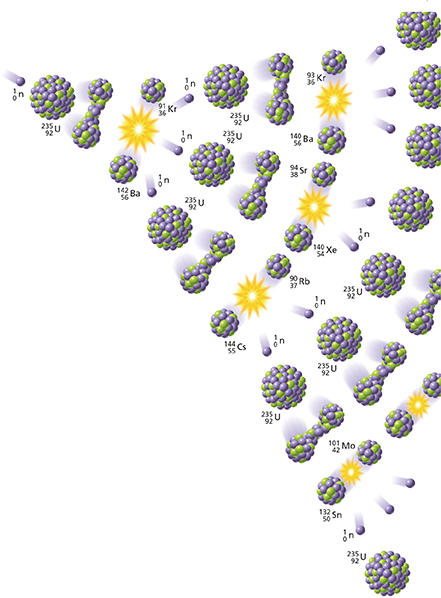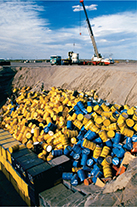Triggering a Chain Reaction How fast does a rumor spread? Imagine that you started a rumor by telling it to three of your friends. Then suppose each of those friends told three more friends. If this pattern continued, the rumor would quickly spread to hundreds of people, even though it originally started with just one person, you.
Nuclear fission can follow a similar pattern, in which one reaction leads to a series of others. During the fission of uranium-235, each reactant nucleus splits into two smaller nuclei and releases two or three neutrons. If one of these neutrons is absorbed by another uranium-235 nucleus, another fission can result, releasing more neutrons, as shown in Figure 19. In a chain reaction, neutrons released during the splitting of an initial nucleus trigger a series of nuclear fissions.
Figure 19 The fission of one nucleus can trigger a chain reaction. The splitting of a uranium-235 nucleus by a neutron yields two or three neutrons, each of which can cause another fission.
Interpreting Diagrams Does the fission of uranium-235 always yield the same isotopes as products? Explain.

The speed of a chain reaction can vary. In an uncontrolled chain reaction, all of the released neutrons are free to cause other fissions, resulting in a fast, intense release of energy. Nuclear weapons are designed to produce uncontrolled chain reactions. In a controlled chain reaction, some of the neutrons are absorbed by nonfissionable materials, resulting in only one new fission for each splitting of an atom. The heat from controlled chain reactions can be used to generate electrical energy. Unfortunately, another product of controlled chain reactions is radioactive waste, shown in Figure 20.
In order to sustain a chain reaction, each nucleus that is split must produce, on average, one neutron that causes the fission of another nucleus. This condition corresponds to a specific mass of fissionable material, known as a critical mass. A critical mass is the smallest possible mass of a fissionable material that can sustain a chain reaction.
Figure 20 A crane lowers drums of radioactive waste into a landfill in Hanford, Washington.


What is a chain reaction?




